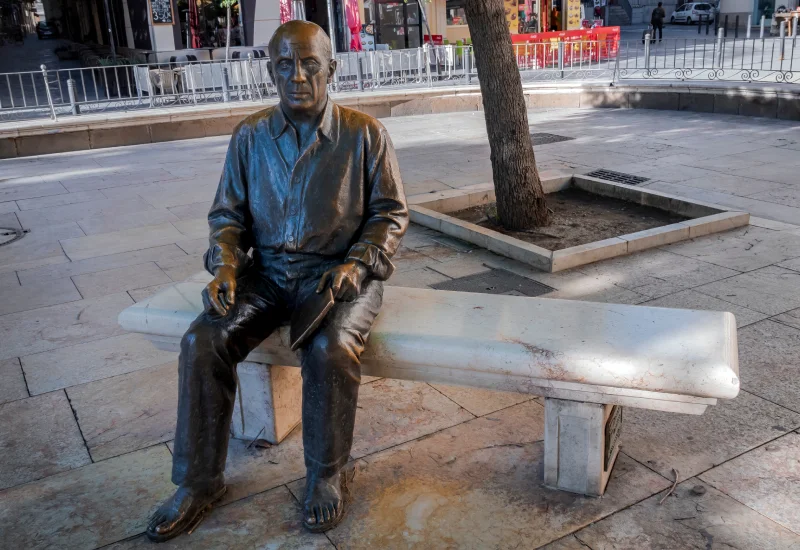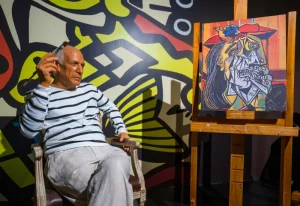Pablo Picasso was one of the most prolific and influential artists of the 20th century. He has created thousands of works in painting, sculpture, calligraphy, drawing, and pottery. Many people know him as an outstanding Spanish artist who is known for his works in Cubism-style art. Pablo Picasso established the Cubism school with Georges Braque among the painters and introduced the technique of mixing colors on the canvas to the world of arts and crafts.
Table of Contents
TogglePablo Picasso Biography
Pablo Picasso, full name Pablo Diego José Francisco de Paula Juan Nepomuceno María de los Remedios Cipriano de la Santísima Trinidad Ruiz y Picasso, was born on October 25, 1881, in Málaga, a city in Spain.
He was the son of an educated painter named José Ruiz y Blasco and María Picasso y López. Picasso changed his name to his mother’s last name in 1901.

Pablo Picasso became interested in painting since his childhood. From the age of 10, with his father, who was a teacher in an art school, he learned the basics of painting, which amused his friends by drawing without lifting the pen or looking at the paper.
Pablo Picasso Learning Art
Although Picasso was weaker in his other studies, he had an extraordinary talent for the arts. He was trained by his father and learned to draw and paint ever since he was a child. At the age of 13, his painting skills surpassed his father’s skills. He was no longer interested in doing schoolwork and preferred to doodle and draw during his school days.
Picasso’s thought on his schooldays: “Because I was a bad student, I was locked in a small cell with white walls and only one bench to sit on. I loved it there because I had a sketchbook with me and I was constantly painting… I could have stayed there forever and painted non-stop.”
Attending Fine Arts School in Barcelona
In 1895, when Pablo Picasso was only 14 years old, his family moved to Barcelona, Spain. He quickly applied to study at the High School of Fine Arts in this city.
The school usually accepted students who were older than him, but his entrance exam was so impressive that the school administrators made an exception and accepted him.

Nevertheless, Picasso could not tolerate the strict rules and regulations of the School of Fine Arts, and instead of attending classes, he wandered the streets of Barcelona and painted urban landscapes and street scenes.
Attending School in Madrid
In 1897, at the age of 16, Picasso went to Madrid to study at the Royal Academy of San Fernando, but the school’s special focus on classical subjects and techniques was a disappointment to him again.
In Madrid, Picasso wandered around the city and painted what he saw instead of taking his classes. He completely abandoned the classical methods he had learned over the years. Throughout his entire life, Picasso sought innovation in art.
Pablo Picasso decided to study the works displayed in the Prado Museum and get to know more artists such as El Greco, Francisco Goya, Diego Velasquez, and Rembrandt. During this time, Picasso was more interested in drawing portraits, and one of his first models was his sister Lola.
Living in Paris
In 1900, for the first time, Picasso went to Paris, which was the main European art scene. At that time, his roommate Max Jacob, who was a poet and a journalist, helped Picasso. They lived in extreme poverty.

In 1901, Picasso went back to Madrid and spent the first half of the year there. He partnered with his friend and illustrated the articles of a magazine. When the first issue of the magazine came out, he had signed his works with the name “Picasso” instead of Pablo Ruiz y Picasso.
In the later stages of his life, Pablo Picasso was considered an international celebrity and was the most famous living artist in the world.
Despite several paparazzi and reporters documenting Picasso’s every move, his art went unnoticed for some time. Picasso continued to create art in the last years of his life. He believed that working would make him survive.
Pablo Picasso Death
On April 8, 1973, Picasso died of heart failure at the age of 91 at his home in Mougins, France, while he and his wife, Jacqueline Roque, were hosting friends for dinner.
As an influential artist of the 20th century, Pablo Picasso had a creative personality. During his 92 years of life, he was constantly searching and experimenting. He had a hand not only in the field of visual arts but also in the field of writing.
His works show the process of the painter’s maturity from childhood naturalism to cubism, surrealism, and beyond. Picasso shaped the path of modern and contemporary art. He witnessed both world wars and had four children during his lifetime.
Pablo Picasso Art
Picasso was famous for his frequent re-creations. The change in his painting style is very apparent, and it might seem his work was created by several artists.

He insisted that he should use the appropriate form and technique in each painting to reach his desired concept.
The Founding of Cubism
Cubism is an art style invented by Pablo Picasso and his painter friend Georges Braque. In Cubism, the painter separates objects and reassembles them into an abstract form.
In this way, the geometric shapes prominently show objects and depict these objects from multiple viewpoints at the same time, and by creating collage-like effects, it violates the concepts of physics.
Pablo Picasso Paintings
Among Picasso’s famous works, Les Demoiselles d’Avignon and Girl Before a Mirror are his most cherished works of art in the Museum of Modern Art in New York. The painting “Les Demoiselles d’Avignon” created by Picasso in 1907, is known as the pioneer and inspiration of the Cubism style.
In this painting, the haunting image of five naked prostitutes drawn in abstract form looks unnatural due to sharp geometric angles and bright blue, green, and gray spots. This painting was not similar to any of the works of Picasso or other painters before him, and it strongly influenced the course of art in the 20th century.

Observe the Man in a Beret (1895) and Portrait of Aunt Pepa (1896) paintings in the Pablo Picasso Museum in Barcelona.
Picasso’s early paintings, including Bread and Fruit Dish on a Table (1909) and Girl with a Mandolin (1910), are known as “Analytical Cubism”.
His later works in the style of cubism are known as “mixed cubism” due to the distinctness from the artistic characteristics of his time and the creation of extensive collages from a large number of small and individual pieces. These paintings include Still Life with Chair Caning (1912), Playing Cards (1913-14), and Three Musicians (1921).
Pablo Picasso Guernica
Guernica is a painting by Pablo Picasso. This work illustrates the bombing of the village of Guernica in Spain by Nazi German bombers on April 26, 1937, during the Spanish Civil War. Guernica is one of Picasso’s most popular works, and many consider it one of the most highly prominent anti-war works in history.

The painting has dimensions of approximately 3.5 x 7.5 meters and was publicly exhibited in the same year as the bombing in France during Picasso’s exile. Today, this painting is kept in the Reina Sofia Museum in Madrid as a treasured painting.
Lastly
Pablo Picasso was known as an extreme person for his works. Yet, he has always been respected for his technical skills, abstract creativity, and his deep empathy for people. Together, these characteristics have made this lively Spaniard known as a revolutionary artist. He devoted almost 80 years of his 91-year-old life to producing art, which he believed would keep him alive. Undoubtedly, Pablo Picasso has significantly contributed to the development of modern art in the 20th century.
Are you planning to visit Europe and looking for a European travel Agency? Check out our Europe Tours and feel free to contact us.







